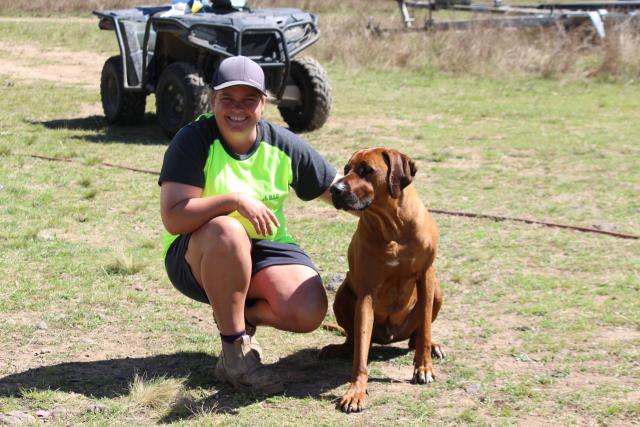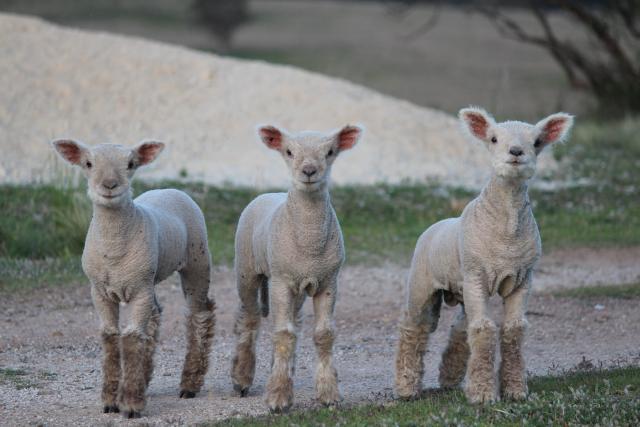By Judy Barnet, Ag Columnist
Friday dawns a glorious day and I won’t allow the fact that I got home from work yesterday to discover the cows had jumped the fence and gone on a rampage, destroying the vegetable garden amongst lots of other plants, to spoil it.
To add insult to injury they refused to exit via the gate, and knocked down yet another fence when they realised my patience had run out. They then refused to go back into their paddock where I had just introduced a bull for the benefit of Varina, the non pregnant cow.
This morning they refused my orders to march up the hill and meet the bull – they just lay down and started chewing their cuds. Naughty cows, Varina you will go in the freezer I told her.
There are so many lambs running around now I can’t count them. The crows got one more, a tiny twin but other than that there have not been anymore dramas. A lot of the lambs go to a creche now with one ewe left in charge to look after them and the others going about their business. Of an evening when all the sheep camp up the top near the gate the lambs play King of the Castle on the Roadbase pile.
A few ewes are still quite poor despite having access to grain as well as minerals etc. The dry ewes are way too fat and need to go into a Jenny Craig Paddock. We are going to get a few of the ewes in and check if they need drenching this weekend. I suspect that they do. It is also time to drench the Merinos which hopefully will be easier to yard than the others.
Dora has a new friend, Rogue, a regal Rhodesian Ridgeback that she has been able to play with for a week. A lot of dogs are intimidated by Dora as she is so boisterous but Rogue, being twice her size, thinks she is just Dandy. He is much more refined than Dora and just stands waiting for her to finish rushing around like a madman then they play. He watches Dora race up to her rock on the point of the dam, leap into the water while he wades out up to his belly and watches as Dora swims back and forwards a few times until they both get out and play again. Rogue is smooth and shiny with a soft glossy coat, Dora is always wet, stinky and dirty and smells of cow poo!
Kermit has hosted two lots of campers and both have left wonderful reviews saying they can’t wait to come back for longer. There is still work to do but it is a good start.
In Warwick a few weeks ago I purchased a second hand book – Wildflowers, Wilderness and Wine by local Stanthorpe Identity Fay Helwig. What an amazing woman who contributed so much in putting Stanthorpe on the tourism map. I am only half way through the book but it is very interesting. I found myself wondering what Fay would think of our farm and its Dad and Dave setup, our gardens sometimes full of sheep or lambs and gardens that always seem to need weeding. Fay has long since retired but her dream lives on and Das Helwig Haus is still alive and thriving under the name of Sabo’s on Severn. I would love to take a visit one day. I imagine it would be picture perfect at this time, the start of spring with all the rain we have received. I also read with interest Fay’s use of Wwoofers – previously Willing Workers on Organic Farms but now World Wide Opportunities on Organic Farms. I too am a Wwoof Host and have been since the early 2000s. Monica and Yves our Tasmanian friends connected with us through Wwoof. Although through Covid we didn’t have any Wwoofers I am still a member and hoping to get some more wwoofers shortly. Your farm does not have to be organic to host, they have membership for non organic hosts as well. As well as helping out with farm jobs the Wwoofers bring with them passion and enthusiasm which can help reignite your own if it is running low! They love learning and you also learn from them. It is a win win situation.
I am enjoying the longer days although normally at this time of year we can eat our dinner on the verandah it has been too cool at night still. I am not complaining about that though, the heat will come soon enough!
I am sorely missing my friend Alex who still has no internet and is unable to edit my column! It has been three weeks now, NBN have been out and advised they need to replace the modem – of which none are available at this time. Alex does an amazing job in putting my writing together which often is more like a diary of events when he receives it. Fingers crossed he will have internet back very soon!
The Timor Pony:
“…And one was there, a stripling on a small and weedy beast,
He was something like a racehorse undersized,
With a touch of Timor pony – three parts thoroughbred at least –
And such as are by mountain horsemen prized.
He was hard and tough and wiry – just the sort that won’t say die…“
Reading Banjo’s famous poem, few spare a thought for the line “- a touch of Timor Pony -” What was it about this relatively unknown, yet substancially influential Breed in Australia’s history?
The Timor Pony has been in Australia in numbers since the early 1800s, with the first stallion having been imported to Sydney in 1803. Although the Timor Pony is not endangered as they continue to exist on Timor Island, they are in danger to being lost to the Australian mainland. The Timor Pony played a crutial part in early Australian horse breeding, but sadly – just like the Waler – this wonderful Breed has been largly forgotten.
Where the Thoroughbred horses could not withstand the tropical conditions and diseases of the Northern Territory, the hardy little Timor not only endured; it flourished. Timors were introduced into Australia en masse from 1820, and trading ships continued to supply the popular demand for Timor Ponies throughout the 19th Century. They landed on the Coburg Peninsula, North-East of Darwin. Many were shipped into the Australian colonies for working duties, intended as pack animals for the explorers, grazers and gold miners of the Territory. They eventually spread throughout all of the Australian colonies, and were hightly valued as tough working ponies.
The Timor pony today can still be found on Timor Island. Outside the regional centers of Timor, the villages use the Timor as a pack and riding animal.
Unfortunately Timor Leste does not keep breeding records and the Timor Pony may have modern breeds introduced over the years.
Living among the hills and gullies of central Timor, the Timor Pony has developed a surprising hardiness and proven stamina. Australian and Dutch Commandos of Sparrow Force and the 2/2nd Indep. Coy, used the Timors for pack and riding duties against the Japanese in WW2 on Timor Island. Without the Timor Pony, resistance against the Japanese could not have continued as long as it did and many wounded soldiers could not have been recovered to fight again.
“After a week Martins and her family decided to brave the enemy and return (PTE Keith) Hayes to his Company. They wrapped him in a blanket, put him on a hardy Timor Pony, and then 3 Timorese guides led him along windy mountain tracks, dodging Jap sentries…“
Yet the Timor Pony is not a formal native to Timor Island, but was introduced around 1292 AD. It roots stem from the Asiatic Wild Horse, of which the Chinese crossed with cavalry horses descended from the Tarpan Pony that Khublai Khan took on a conquest of the Indonesian Islands in 1292. The remnants and descendants scattered through the Islands were the progenitors of the Timor Pony.
Two elements constitute the Timor pony; The Tarpan (equus caballus przevalskii gmelin), and the Asiatic Wild Horse (equus caballus przevalskii przevalskii) – also known as ’Przevalski’s Horse’. Both these are ancient horses. The Tarpan no longer exists today, whereas the Przevalski Horse has been bred back from the brink of extinction. The Portugese Garrano, Sorraria and the British Exmoor Pony are other pony breeds that also represent a mix of ancient horse genes, and share a common bloodline along with the Timor Pony.
The Australian Pony owes much of its breed existence to the Timor Pony, where Timors were initially mixed with the Hungarian pony, Thoroughbred horse, Shetland ponies, and Welsh ponies. The Timor pony is now endangered to the mainland of Australia, with less than a handful of registered animals. A small group of volunteers have recently set up a working group, so that the Timor Pony can be preserved and can flourish, as it has done for near 200 years.
The previous excerpt was authored by Richard Crispin, who was a valued member of the Rare Breeds Trust for many years until his passing in 2021, and changed slightly by Barb Bleicher. Timor Pony Semen has also been donated to the Rare Breeds Trust of Australia.








